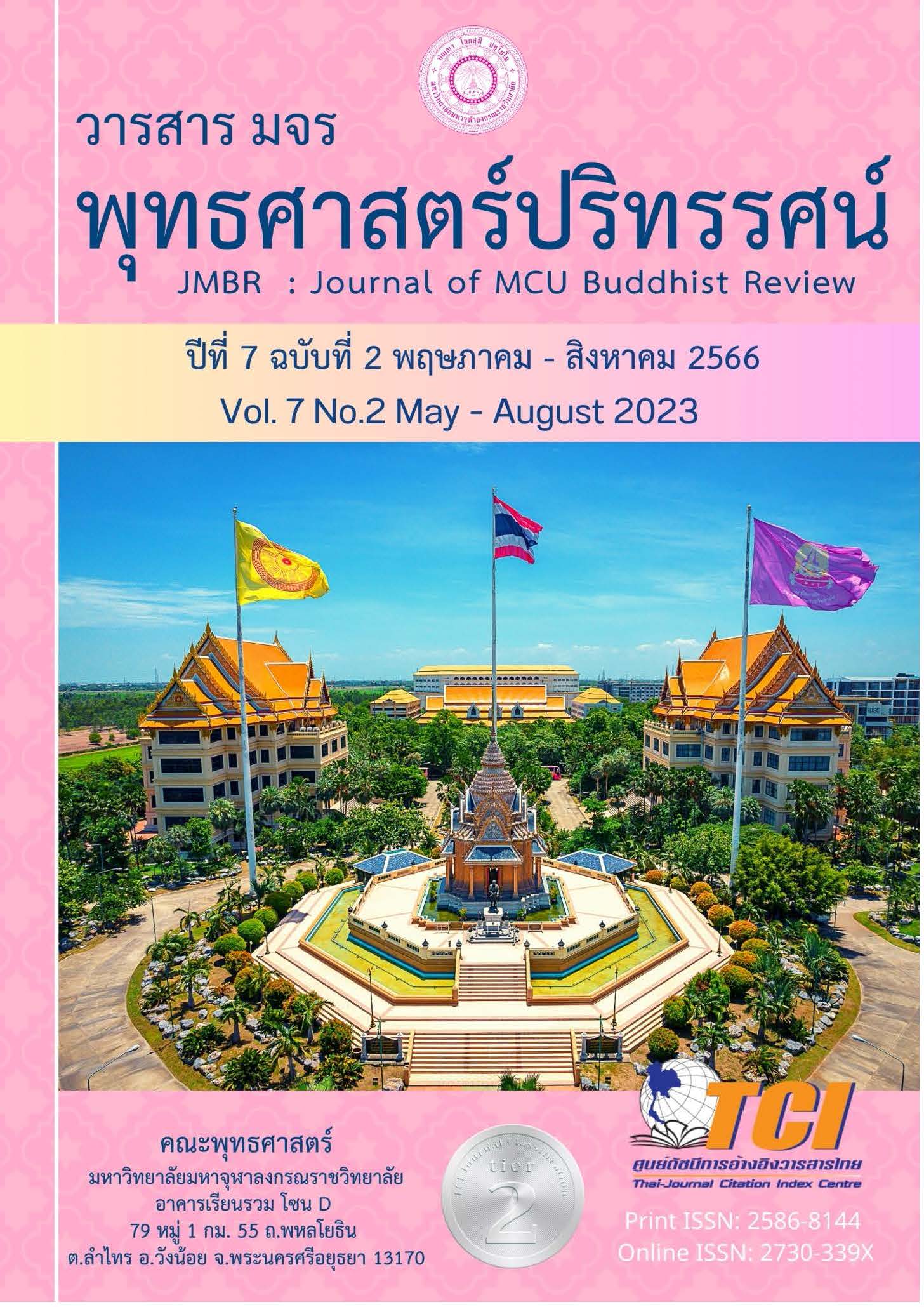วิเคราะห์อัตลักษณ์วัฒนธรรมเชิงพระพุทธศาสนาจากผลกระทบ ด้านการท่องเที่ยวเชิงวัฒนธรรมในชุมชนอพยพชาวทิเบต เมืองธรรมศาลา รัฐหิมาจัลประเทศ สาธารณรัฐอินเดีย
Main Article Content
บทคัดย่อ
บทความวิจัยนี้มีวัตถุประสงค์ 1) เพื่อศึกษาบริบททางสังคมและวัฒนธรรมของชุมชนอพยพชาวทิเบตเมืองธรรมศาลา รัฐหิมาจัลประเทศ สาธารณรัฐอินเดีย 2) เพื่อศึกษาอัตลักษณ์วัฒนธรรมเชิงพระพุทธศาสนาของชุมชนอพยพชาวทิเบตเมืองธรรมศาลา รัฐหิมาจัลประเทศ สาธารณรัฐอินเดีย 3) เพื่อวิเคราะห์อัตลักษณ์วัฒนธรรมเชิงพระพุทธศาสนาของชุมชนอพยพชาวทิเบตเมืองธรรมศาลา รัฐหิมาจัลประเทศสาธารณรัฐอินเดีย เป็นงานวิจัยเชิงคุณภาพ ข้อมูลภาคสนาม กำหนดกลุ่มเป้าหมาย คือ ผู้ที่พักอาศัยและท่องเที่ยวในชุมชนอพยพชาวทิเบต เมืองธรรมศาลา จำนวน 45 คน วิเคราะห์ข้อมูลเอกสาร เชื่อมโยงไปสู่แนวคิดและทฤษฎี และนำเสนอผลวิจัยเชิงพรรณนา
ผลการวิจัยพบว่า 1) ชุมชนอพยพชาวทิเบตมีการอพยพเข้ามาตั้งถิ่นฐานอยู่ในบริเวณดังกล่าว ภายหลังกองทัพปลดแอกประชาชนจีนเข้าไปยึดครองจนเกิดเหตุจลาจลครั้งใหญ่ มีการจัดตั้งรัฐบาลพลัดถิ่น มีการสร้างวัดโดยถอดแบบจำลองจากทิเบต และมีองค์ทะไลลามะที่ 14 ทรงพำนักประจำที่นี่ คนทั่วไปจึงรู้จักสถานที่นี้ว่าเป็นลาซาน้อย 2) อัตลักษณ์วัฒนธรรมเชิงพระพุทธศาสนาของชุมชนอพยพชาวทิเบต มี 4 ด้าน คือ ด้านสังคม ได้แก่ ระบบการปกครองที่มีความเป็นอัตลักษณ์เฉพาะ มีองค์ทะไลลามะ ซึ่งชาวทิเบตเชื่อว่าเป็นพระอวโลกิเตศวรกลับชาติมาเกิดอยู่สูงสุด ด้านวัฒนธรรม มีลักษณะจำเพาะ เช่น การแต่งกาย การเต้นรำ เป็นต้น ด้านวิถีชีวิต เป็นวิถีชีวิตที่เรียบง่าย มีความสัมพันธ์กันในชุมชนเล็กๆ ไม่มีความสลับซับซ้อน อิงกับพระพุทธศาสนาอยู่ตลอดเวลา และด้านพระพุทธศาสนา มีความเชื่อและข้อปฏิบัติทางศาสนาที่บ่งบอก อัตลักษณ์ของชุมชน 3) จากผลกระทบด้านการท่องเที่ยวเชิงวัฒนธรรมแนวโน้มอัตลักษณ์วัฒนธรรมในชุมชนอพยพชาวทิเบต มีการเปลี่ยนแปลงทั้งด้านบวก คือ การสร้างความมั่นคงทางเศรษฐกิจในชุมชน และด้านลบ คือส่งผลกระทบทางด้านสิ่งแวดล้อม สังคม และวัฒนธรรม แต่อย่างไรก็ตามชาวทิเบตส่วนใหญ่ยังยึดโยงกับพระพุทธศาสนาวัชรยาน ความมีอยู่ขององค์ทะไล ลามะ เป็นหลักยึดเหนี่ยวจิตใจ ซึ่งวิถีชีวิตแบบนี้มีแนวโน้มอยู่คู่ชาวทิเบตต่อไป อย่างน้อยในช่วงชีวิตของผู้อพยพชาวทิเบตรุ่นแรก
Article Details

อนุญาตภายใต้เงื่อนไข Creative Commons Attribution-NonCommercial-NoDerivatives 4.0 International License.
- บทความที่ได้รับการตีพิมพ์เป็นลิขสิทธิ์ของวารสาร มจร พุทธศาสตร์ปริทรรศน์
- ข้อความใดๆ ที่ปรากฎในบทความที่ได้รับการตีพิมพ์ในวารสาร ถือเป็นความรับผิดชอบของผู้เขียนบทความ และข้อคิดเห็นนั้นไม่ถือว่าเป็นทัศนะและความรับผิดชอบของกองบรรณาธิการวารสาร มจร พุทธศาสตร์ปริทรรศน์
เอกสารอ้างอิง
กฤษดาวรรณ หงศ์ลดารมภ์. (2546). ทิเบต ขอบฟ้าที่สูญหายไป. กรุงเทพฯ: เรือนแก้วการพิมพ์.
ทะไลลามะ. (2537). ความสุขในต่างแดน. แปลโดย ธรรมนูญ ศริโสภณ. กรุงเทพฯ: คลังปัญญา.
ทะไลลามะ. (2536). แผ่นดินและประชากรของข้าพเจ้า. แปลโดย ส. ศิวรักษ์. กรุงเทพฯ: ส่องศยาม จำกัด.
ทวีวัฒน์ บุณฑริกวิวัฒน์. (2545). ศาสนาและปรัชญาในจีน ทิเบต และญี่ปุ่น. กรุงเทพฯ: สุขภาพใจ.
ประมวล เพ็งจันทร์. (2558). ไกรลาส การจาริกบนวิถีแห่งศรัทธา. กรุงเทพฯ: อมรินทร์ธรรมะ.
มหาจุฬาลงกรณราชวิทยาลัย. (2539). พระไตรปิฎกภาษาไทย ฉบับมหาจุฬาลงกรณราชวิทยาลัย. กรุงเทพฯ: มหาจุฬาลงกรณราชวิทยาลัย.
สัญญา ศัลศาลา. (2562). การเมืองเรื่องสัญชาติของผู้ลี้ภัยทิเบตในประเทศอินเดีย. วารสารมานุษยวิทยาศาสนา. 1(1), 10-29.
เอ. ทอม กรุนเฟลด์. (2003). ทิเบตที่เป็นจริง. แปลโดย ส. สุวรรณ. กรุงเทพฯ: สุขภาพใจ.
Audrey, P. (2006). The problem with ‘rich refugees’ sponsorship, capital, and the informal economy of Tibetan refugees. Modern Asian Studies. 40(1), 233-253.
Collins-Kreiner, N. (2010). Researching pilgrimage: Continuity and transformations. Annals of tourism research. 37(2), 440-456.
Gupta, E. (2017). Tourism in Himachal Pradesh. International Journal of Engineering Research & Management Technology. 2(3), 181-191.
Rigzin, T. (2016). The Exile Tibetan Communiny: Problams and Propects. Dharamshala H.P.: Library of Tibetan Works & Archivs.


